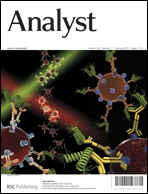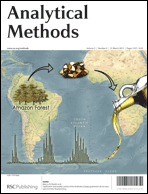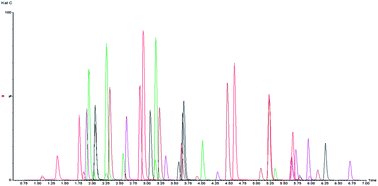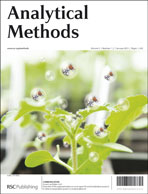During the months April – June, the following articles are in the Top Ten most accessed:-
Selective screening of trace trazine herbicides in tomato samples employing dummy molecularly imprinted solid-phase extraction coupled with liquid chromatography
Fang Wang, Hongyuan Yan, Ruijun Wu, Tianyu Cai, Kun Han and Zhao Li
Anal. Methods, 2013,5, 2398-2405
DOI: 10.1039/C3AY40145F
Electrochemical sensing and biosensing based on square wave voltammetry
Aicheng Chen and Badal Shah
Anal. Methods, 2013,5, 2158-2173
DOI: 10.1039/C3AY40155C
Photocatalytic reduction of CO2: a brief review on product analysis and systematic methods
Jindui Hong, Wei Zhang, Jia Rena and Rong Xu
Anal. Methods, 2013,5, 1086-1097
DOI: 10.1039/C2AY26270C
Heat-shock transformation of Escherichia coli in nanolitre droplets formed in a capillary-composited microfluidic device
Jun Sha, Yaolei Wang, Jianchun Wang, Wenming Liu, Qin Tu, Ajing Liu, Lei Wang and Jinyi Wang
Anal. Methods, 2011,3, 1988-1994
DOI: 10.1039/C1AY05189J
Facile and sensitive paper-based chemiluminescence DNA biosensor using carbon dots dotted nanoporous gold signal amplification label
Yanhu Wang, Shoumei Wang, Shenguang Ge, Shaowei Wang, Mei Yan, Dejin Zang and Jinghua Yu
Anal. Methods, 2013,5, 1328-1336
DOI: 10.1039/C2AY26485D
Analytical techniques for single-liposome characterization
Chaoxiang Chen, Shaobin Zhu, Tianxun Huang, Shuo Wang and Xiaomei Yan
Anal. Methods, 2013,5, 2150-2157
DOI: 10.1039/C3AY40219C
Copper oxide nanoleaves decorated multi-walled carbon nanotube as platform for glucose sensing
Zhiyu Yang, Jinsheng Feng, Jinshuo Qiao, Yiming Yan, Qiyao Yu and Kening Sun
Anal. Methods, 2012,4, 1924-1926
DOI: 10.1039/C2AY25283J
Rhodamine and BODIPY chemodosimeters and chemosensors for the detection of Hg2+, based on fluorescence enhancement effects
M. J. Culzoni, A. Muñoz de la Peña, A. Machuca, H. C. Goicoechea and R. Babiano
Anal. Methods, 2013,5, 30-49
DOI: 10.1039/C2AY25769F
Experimental design and optimisation (4): Plackett–Burman designs
Analytical Methods Committee
Anal. Methods, 2013,5, 1901-1903
DOI: 10.1039/C3AY90020G
Non-enzymatic glucose sensor based on three dimensional nickel oxide for enhanced sensitivity
Chunyan Guo, Yinmei Wang, Yongqing Zhao and Cailing Xu
Anal. Methods, 2013,5, 1644-1647
DOI: 10.1039/C3AY00067B
Why not take a look at the articles today and blog your thoughts and comments below.
Fancy submitting an article to Analytical Methods? Then why not submit to us today or alternatively email us your suggestions.
Comments Off on Top ten most accessed articles from April – June 2013
















